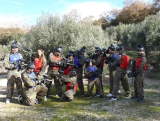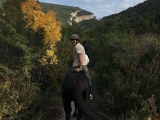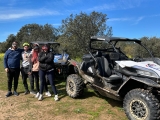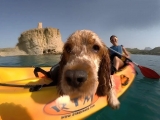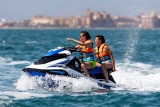But first, we’d like to acknowledge that today marks 4 years since the passing of Darío Barrio, chef and BASE jumper (may he rest in peace), whom we interviewed several years ago. You can revisit the interview here.

Yumping.- Carlos, how did your passion for jumping begin?
Carlos Pedro Briceño.- Since childhood, I’ve always been fascinated by flying. Basically from watching Superman cartoons and those superheroes who could fly.
Y.- Do you remember your first skydive?
C.P.B.- It was on 19th June 1999 at a small drop zone called "Cliff Parachute School" in a town named San Juan de los Morros, about two and a half hours from Caracas, Venezuela’s capital. Several friends went—only a few still jump today. It was intense because you had to hang from the wing of a Cessna 185 and let go when the instructor gave the order. The instructor would deploy your parachute the moment you released.

Y.- What made you transition to BASE jumping?
C.P.B.- When I’d done about 800 skydives, I was hosting a TV show about extreme sports and included it as part of an episode. The jump was from a 70m bridge near Caracas International Airport, Venezuela. Afterward, I was hooked on the sensation and adrenaline.
Y.- For any newcomers among our adventurers, could you explain what BASE jumping is in simple terms?
C.P.B.- BASE jumps are leaps from fixed structures. The word B.A.S.E. is an acronym: B. Building, A. Antenna, S. Span (bridges), E. Earth (cliffs, mountains).

Y.- It’s hard to convey what you feel when jumping, but can you help us imagine it?
C.P.B.- I jump for that incredible feeling of flying from a fixed structure. The peace as your feet leave the object is unique, followed by the rapid, intense acceleration of freefall.
Y.- What goes through your mind during a jump?
C.P.B.- I live entirely in the present—no thoughts beyond that moment. I always feel fear, which is part of the ritual and crucial for staying alert to safety details. Fear keeps you alive; panic kills.

Y.- Extreme sports always involve risk... How safe or unsafe do you consider BASE jumping?
C.P.B.- Unlike other sports, any BASE accident is serious or fatal. But with awareness—ideal weather, proper gear, and avoiding unproven maneuvers—it’s as safe as any extreme sport. Difficulty and risk exist; it’s on us to minimise them.
Y.- How would you convince someone outside this world that the risk is worth it?
C.P.B.- You can’t convince anyone to take risks—it must come from within. If they’re genuinely curious, I’d explain how safe it can be and how rewarding it feels to be 100% alive.

Y.- How did you join the global BASE jumping elite? What does that mean?
C.P.B.- I don’t see myself as elite—just part of a niche sport. Popularity comes from years of practice.
Y.- How does a BASE jumper train and stay fit?
C.P.B.- BASE doesn’t demand peak fitness, but it helps—especially hiking mountains to jump. I’ve always been athletic and active.
Y.- Favourite place you’ve jumped?
C.P.B.- The Alps, Norway’s fjords—but Angel Falls in Venezuela is uniquely special.
Y.- Dream jump location?
C.P.B.- Yosemite Park, California.
Y.- Do you practice other adventure sports?
C.P.B.- I’ve done many: surfing, kite surfing, mountain biking, rock climbing, alpine climbing, triathlons, adventure races...
Y.- Any sport you’d love to try?
C.P.B.- Speedflying—I’ll likely try it this summer.

Y.- On a scale of 1-10, how central is adrenaline to your life?
C.P.B.- Close to 10.
Y.- Next challenge?
C.P.B.- To keep enjoying what I do and make a living from it.
Y.- A place that’s captivated you?
C.P.B.- Anywhere with mountains.

Y.- Have you jumped in Spain? If so, where? If not, where would you?
C.P.B.- Yes—Benidorm (placed 4th in a competition), Riglos, and Montserrat (where I was first to do a proximity line).
Y.- Would you recommend BASE jumping to friends/family?
C.P.B.- Absolutely—but only for those born for it. Hesitation won’t cut it; it’s too intense.
Y.- How would you like to be remembered in BASE jumping?
C.P.B.- As someone who loved it deeply and practised it smartly and safely.





